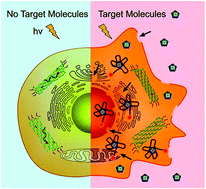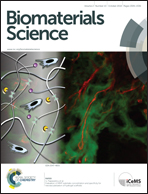On-demand generation of singlet oxygen from a smart graphene complex for the photodynamic treatment of cancer cells†
Abstract
Graphene oxide (GO) has been proven to be a highly efficient long-range quencher for various fluorescence processes, which intrinsically work through a photophysical mechanism similar to that of singlet oxygen generation (SOG). Under our hypothesis that GO may be capable of quenching the SOG process, here we design and synthesize a novel nanocomplex consisting of GO, a photosensitizer and an aptamer. We demonstrate that GO is an ideal SOG controller, which can reversibly quench and recover SOG depending on the interaction intensity between GO and a photosensitizer. Additionally, it can simultaneously act as a carrier for the efficient loading and delivery of the photosensitizers to cancer cells. Thus, during the delivery process, SOG of the nanocomplex can be completely inhibited by the quenching capacity of the GO even though there is light present; however, when the nanocomplex enters into cancer cells where target molecules are present, SOG is triggered by a target binding event and singlet oxygen is reversibly released from the nanocomplex, ultimately inducing significant cell death in the presence of light. This proof-of-concept study provides a new chemical strategy for creating a highly selective photodynamic therapy with low toxicity, using hydrophilic GO-based systems.


 Please wait while we load your content...
Please wait while we load your content...